
|
You entered: impact
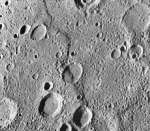 Mercury's Faults
Mercury's Faults
21.01.1996
The surface of the planet Mercury is not without fault. In this case, however, "fault" refers to unusual surface features that are the topic of much speculation. The above fault line is called Santa Maria Rupes, and runs through many prominent craters.
 560 Kilometers Above Europa
560 Kilometers Above Europa
3.03.1998
This is the closest photograph ever taken of Europa. Last December, NASA's spacecraft Galileo swept past the Jovian moon and took photographs which were released yesterday. Speculation that life-bearing oceans exist beneath Europa's surface caused NASA to put Galileo on orbits that approach Europa.
 A Flyby View of Ganymede
A Flyby View of Ganymede
25.10.1996
This is what it would look like to fly over the surface of Jupiter's moon Ganymede. NASA's robot spacecraft Galileo recently approached only 6000 miles from this frozen ice-ball of a moon. The above image is a digital reconstruction from two images taken during this flyby.
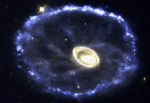 The Cartwheel Galaxy
The Cartwheel Galaxy
2.07.1995
The Cartwheel Galaxy shows a ring that is the result of a collision between a small and a large galaxy. After a small galaxy has moved through a big galaxy - in this case...
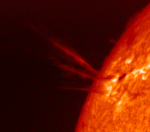 A Solar Corona Ejection
A Solar Corona Ejection
8.11.1996
The Sun would not be a nice place to spend the summer. One reason, besides the extreme heat, is that explosions are common there. In the above picture, magnetic fields buckle releasing previously constrained hot material from the upper atmosphere of the Sun.
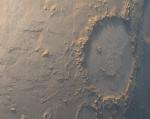 Happy Face Crater on Mars
Happy Face Crater on Mars
15.03.1999
Even Mars can put on a happy face. The Martian crater Galle has internal markings reminiscent of a smiley face symbol. Such markings were originally discovered in the late 1970s in pictures taken by the Viking Orbiter. A large meteor impacted the Martian surface to form the crater.
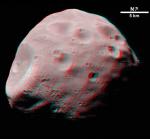 Stereo Phobos
Stereo Phobos
20.11.2004
Get out your red/blue glasses and float next to Phobos, grooved moon of Mars! Also featured in yesterday's episode, the image data from the Mars Express High Resolution Stereo Camera and was recorded at a distance of about 200 kilometers.
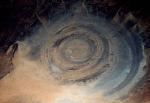 Earth's Richat Structure
Earth's Richat Structure
5.01.1998
What on Earth is that? The Richat Structure in the Sahara Desert of Mauritania is easily visible from space because it is nearly 50 kilometers across. Once thought to be an impact crater, the Richat Structure's flat middle and lack of shock-altered rock indicates otherwise.
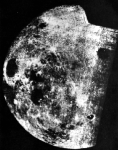 The Far Side
The Far Side
14.09.1995
This historic picture was humanity's first glimpse of the far side of the Moon. It was taken by the Soviet spacecraft Luna 3 in October of 1959. Luna 3 followed closely...
10.05.2004
Scroll right to see the inside of Endurance Crater, the large impact feature now being investigated by the Opportunity rover rolling across Mars. The crater's walls show areas of light rock that might hold clues about the ancient watery past of this Martian region.
|
January February March April May June July |
|||||||||||||||||||||||||||||||||||||||||||||||||